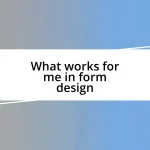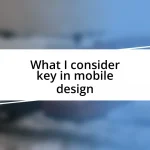Key takeaways:
- Clarity and consistency in icon design are essential for effective user communication and experience.
- Color and contrast significantly influence usability; high contrast and consideration for accessibility are crucial.
- Gathering user feedback and iterative design processes enhance icon usability, ensuring designs resonate with users.
![]()
Understanding Icon Design Principles
In my experience with icon design, clarity is paramount. Icons should communicate their meaning at a glance, without any ambiguity. I’ll never forget the time I misused a generic lock icon for a feature about notifications. It confused users and led to unnecessary frustration—an important reminder that each design choice carries significant weight.
Another principle I deeply value is consistency. When icons share a similar style and visual language, they create a cohesive experience. During a project where I designed an icon set, I found that using the same stroke weight and color palette made a world of difference. It was like creating a family of icons that could confidently stand together, resonating better with users.
Finally, scalability is something I learned the hard way. When designing for different screen sizes, I realized how vital it is that icons retain their integrity across various contexts. Just imagine trying to decipher an overly intricate icon on a small mobile screen—frustrating, right? By focusing on simplicity in detail, I’ve been able to create icons that are both functional and visually appealing, regardless of where they appear.
![]()
Choosing the Right Icon Style
Choosing the right icon style is all about aligning your design with the overall project goals. When I faced the challenge of selecting an icon style for a fitness app, I leaned toward a playful, rounded style that resonated well with the target audience—active individuals looking for motivation. It was rewarding to see users relate to the icons immediately, feeling a sense of connection that motivated them to engage more with the app.
On another occasion, I experimented with a minimalist line style for a tech-related website. At first, I thought it might come off as too stark, but I was pleasantly surprised at how perfectly it matched the brand’s modern aesthetic. The clean lines and open spaces allowed the icons to breathe, making the interface feel more sophisticated and user-friendly. It turned out that choosing the right style often hinges on the emotions you want to evoke in your users.
When working with icon styles, I always keep in mind the role of cultural perception in design. For example, while designing for an international audience, I learned that a thumbs-up icon doesn’t carry a universally positive meaning. This experience reinforced the idea that understanding the context in which your icons will be used is just as crucial as the design choices themselves.
| Icon Style | Best For |
|---|---|
| Playful/Rounded | Engaging/Youthful audiences |
| Minimalist/Line | Modern/Sleek interfaces |
| Bold/Solid | Strong brand identity |
| Detailed/Illustrative | Creative storytelling |
![]()
Utilizing Color and Contrast Effectively
When working on icon design, I’ve found that color and contrast play pivotal roles. There was a time when I designed a series of icons for a health app, and selecting the right color palette was a game changer. Initially, I aimed for softer pastels, but they didn’t pop visually against the white background. After rethinking my approach, I switched to bolder hues with high contrast. This small change made my icons not only more visible but also more engaging for users.
Here are some key takeaways I’ve discovered through experimentation:
- High Contrast: Use contrasting colors to make icons stand out and ensure they are easily recognizable at a glance.
- Color Psychology: Different colors evoke different feelings; for instance, green suggests health and freshness, while blue exudes trust and reliability.
- Accessibility: Always consider color blindness—incorporate patterns or textures so that important icons remain discernible to all users.
- Cohesion: Stick to a limited color palette that aligns with your brand to create a cohesive and professional look.
By prioritizing these elements, I’ve witnessed the positive impact they have on user experience, reinforcing the idea that thoughtful color choices can elevate icon design to a whole new level.
![]()
Creating Scalable Vector Graphics
Creating scalable vector graphics (SVGs) is where I’ve found a blend of art and functionality in icon design. When I first began using SVGs, I was amazed at how effortlessly they resized without sacrificing quality. I remember designing a set of icons for a mobile application; adjusting their size for different screen resolutions opened my eyes to the versatility of vector graphics. Have you ever noticed how crisp and clear SVGs look on any device? That’s the beauty of them, and it emphasizes the importance of scaling.
One of the aspects I particularly enjoy is the ease of manipulating SVGs through code. There was a project where I needed to tweak an icon’s color directly within the SVG file. Instead of re-exporting from the design software, I simply adjusted the fill attribute in the code, and voilà! The new color reflected instantly across all instances. This flexibility not only saved me time but also ignited my creativity—imagine how one slight change can transform the entire visual experience.
As I delve deeper into icon design, I always keep in mind the balance between detail and simplicity in SVGs. When rendering intricate designs, I learned the hard way that too much complexity can slow down website performance. I once created an overly detailed icon that looked great but loaded slowly, leading to a frustrating user experience. This taught me that scalability isn’t just about resizing—it’s also about ensuring efficiency, making it crucial to maintain clarity without overwhelming the viewer. How do you approach this balance in your designs?
![]()
Testing Your Icons for Usability
When it comes to testing icons for usability, I’ve often found that it’s essential to gather real user feedback. Early in my career, I designed a set of navigation icons for a travel app, and after initial roll-out, I conducted a usability test with actual users. The results were enlightening; many had difficulty identifying what some icons represented, which highlighted the importance of user-centered design. Have you ever watched users interact with your designs? Their instinctive reactions can point out issues you’d never noticed.
Observing users directly helped me understand the nuances of icon interpretation. I recall one instance where I used an abstract icon for ‘settings,’ thinking it looked modern and sleek. However, during testing, users often confused it for ‘search’ or ‘add.’ This experience taught me that simplicity and clarity often trump aesthetics. I now emphasize testing icons in different contexts to see how they function within the flow of the application. Are they intuitive enough to stand alone, or do they require more context?
A strong takeaway from my testing experiences is the significance of iterative feedback. Each test round reveals new insights, allowing for optimization that continually aligns with user expectations. I’ve learned to embrace constructive criticism—every piece of feedback is like a stepping stone in perfecting your icons. How do you approach feedback collection in your projects? Engaging with users has transformed my design approach and deepened my appreciation for the usability of icons.
![]()
Gathering Feedback and Iterating
Gathering feedback is a crucial part of the icon design process for me. I recall a project where I presented a set of icons to my team, eager to hear their thoughts. Initially, I believed I had created something extraordinary, but their feedback revealed that some icons felt too similar. It was a lightbulb moment—sometimes, when you’re deeply involved in your work, it’s hard to see beyond your vision. Have you ever thought a design was flawless only to find out it needed more clarity?
Iterating based on feedback has transformed my design method. After making adjustments to differentiate those similar icons, I decided to test them again with a small group of users. The relief I felt when they could easily distinguish between them was incredible. This iterative loop not only refined my designs but also nurtured a sense of community. The process taught me that every piece of feedback is a gift that can elevate your design, allowing it to resonate more deeply with users. How often do you seek out feedback, and what changes have resulted from it?
I’ve also found that the medium of feedback can greatly impact its effectiveness. In one project, I used a survey to gather opinions on icon aesthetics, but I realized that a face-to-face discussion sparked far more insightful conversations. Engaging with users and other designers in real-time can uncover nuances that written responses may miss. It’s all about making connections and fostering dialogue. How do you facilitate meaningful conversations around your designs? Embracing these moments of vulnerability has been essential in my journey toward creating icons that truly resonate.
![]()
Building a Consistent Icon Set
Building a consistent icon set starts with establishing a design language that resonates throughout all icons. I remember a project where I crafted icons for a mobile application, and I decided to create a style guide that defined colors, shapes, and line weights. This acted as a reference that kept everything cohesive. Have you ever tried defining your style parameters before diving into designs? I learned that this preliminary step can save you from headaches down the line.
In my experience, everyone sees colors and shapes differently, and creating visual harmony is essential. While working on an icon set for a dashboard, I intentionally used a rounded style to evoke a friendly feel, ensuring that all icons carried the same rounded edges and consistent color palette. Each time I tweaked one icon, I paused to gauge how it fit within the overall design. It’s fascinating how a single inconsistency can disrupt the visual flow. Have you ever noticed how one off-key note can change an entire melody?
I’ve also found that using a grid system is invaluable for maintaining consistency. It gives all icons a sense of structure and alignment, akin to a composer arranging notes on a staff. I vividly remember aligning my icons using a grid during a particularly challenging project, and it not only streamlined the design process, but it also enhanced the overall aesthetic. The icons felt like they belonged together. How do you ensure that your designs maintain a sense of unity? Embracing these tools can elevate your icon set from a collection of images to a cohesive communication tool.










